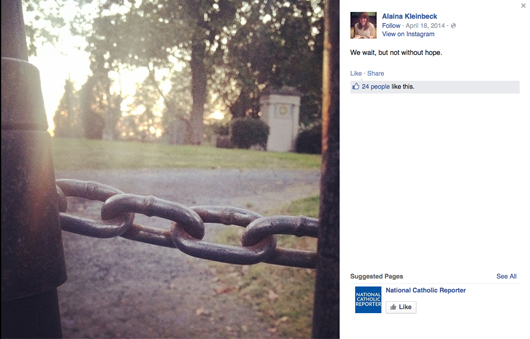Parents, youth workers and anyone who has spent time with a young person know that communication matters to young people.
The young do, in fact, communicate at higher rates than other age groups, but it isn’t simply about words. Young people are in touch with their friends and family using pictures, emojis and animated images called GIFs.
For those of us who grew up calling people on the phone, writing letters or showing up on friends’ doorsteps, this kind of image-mediated communication can seem strange and awkward, even less authentic. But to the young, this is being in touch, being connected, being real.
How, then, can we start thinking about newer forms of communication as powerful tools for helping young people grow in their Christian formation and in their relationship with God?
The possibilities are particularly evident during Lent. As an early millennial, I tend to see two types of posts in my social media feeds.
The first is a blacked-out profile picture accompanied by words like “See ya at Easter, folks! Facebook fasting for Lent.” Fasting from social media is a favorite of older millennials and other generations, but for younger people, it’s the equivalent of turning off the Wi-Fi, turning off the cellphone, soldering the mailbox closed and unplugging the last remaining house phone.
The second type of post I see during Lent is a photo from the user’s day accompanied by a series of hashtags, such as #lentphotoaday #40daysoflent.
These two kinds of posts are by no means the full extent to which people practice the liturgical season or express their practice on social media. But they illustrate the possibilities that we leave untapped if we ignore or disengage with social media and other mediated communications.

Images can be particularly powerful in Christian practice. Now that most of us carry cameras in our pockets, image creation or image journaling as a spiritual practice is readily accessible.
Sarah Dunlop, a visual ethnographer from the University of Birmingham, has demonstrated in her work with young Polish immigrants in the U.K. that when young people take photos of sacred things, they are able to articulate spiritual matters in a profoundly personal way. The creation of images initiates a process of deep self-revelation that may not be available through words alone.
When we observe our surroundings through a photographic lens, it may be that we feel greater permission to read meaning into or out of our material existence. In taking photos, our bars of soap and visits to still-water lakes become beautiful observations of simple things. Suddenly, God shows up in our daily existence. Our eyes become trained to see sacred gifts in ordinary places.
Teaching young and old how to employ their communication habits as aids to spiritual formation requires time and practice -- and a bit of willingness on our part to take the first plunge.
It begins with experiencing photographic prayer ourselves, on our own and in small groups, before inviting others to do it.

For those of us who are less than tech-savvy, there are surely young techies in our churches who would be curious enough about this fresh approach to spiritual expression to help us get started.
As a next step, we can encourage members of the church community to take photos throughout the week in response to the Sunday lessons, jump-starting a whole new kind of engagement from members, not just the young.
Reminders are made easy through text messaging services and apps. The weekly practice of reviewing photographs can be incorporated naturally at the beginning of time together in small groups or in sharing testimonies during worship.
All of this might sound like a lot of work. And it may be. But if communicating God’s grace is a primary task of Christian leadership in the church and in the community, then connecting with our young -- and not-so-young -- through this new means of spiritual expression is indeed important work.








